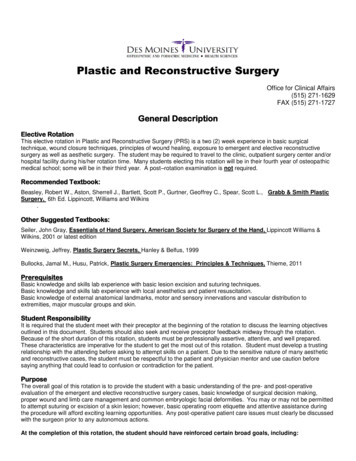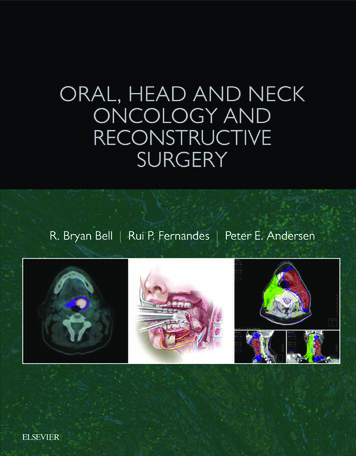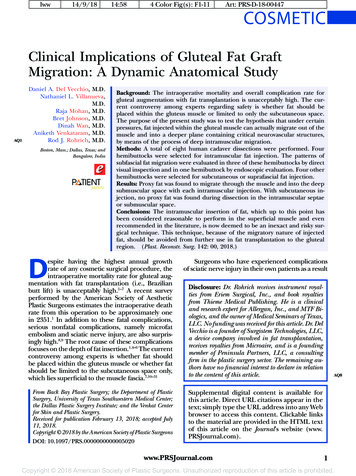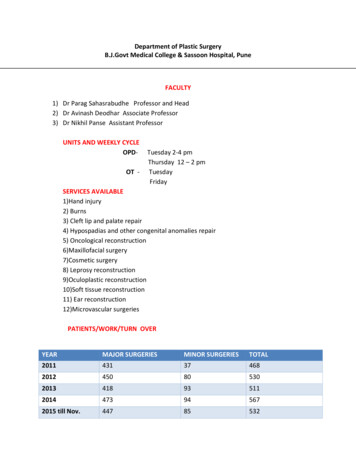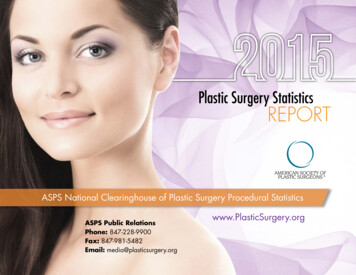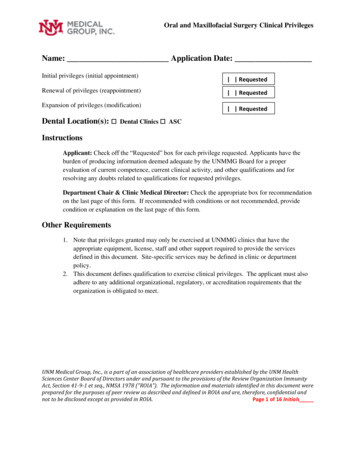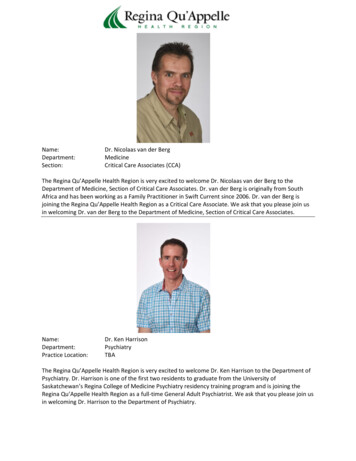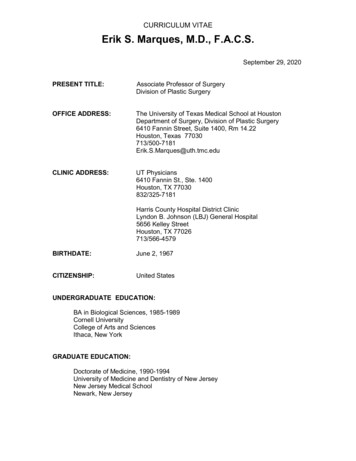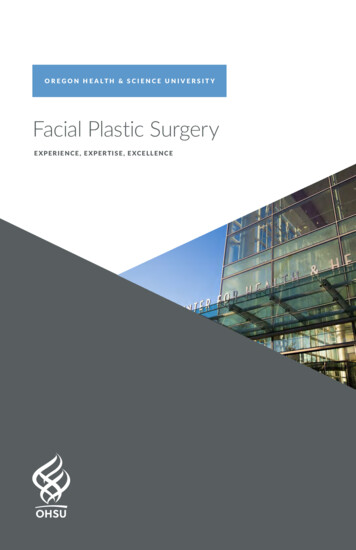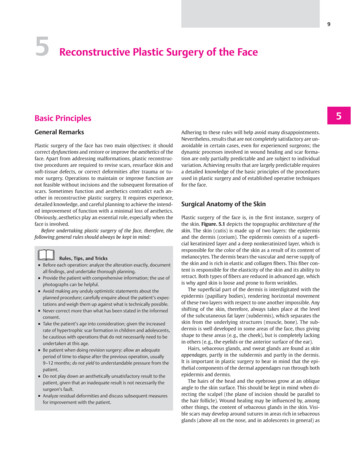
Transcription
95Reconstructive Plastic Surgery of the Face445Basic PrinciplesGeneral RemarksPlastic surgery of the face has two main objectives: it shouldcorrect dysfunctions and restore or improve the aesthetics of theface. Apart from addressing malformations, plastic reconstructive procedures are required to revise scars, resurface skin andsoft-tissue defects, or correct deformities after trauma or tumor surgery. Operations to maintain or improve function arenot feasible without incisions and the subsequent formation ofscars. Sometimes function and aesthetics contradict each another in reconstructive plastic surgery. It requires experience,detailed knowledge, and careful planning to achieve the intended improvement of function with a minimal loss of aesthetics.Obviously, aesthetics play an essential role, especially when theface is involved.Before undertaking plastic surgery of the face, therefore, thefollowing general rules should always be kept in mind: Rules, Tips, and TricksBefore each operation: analyze the alteration exactly, documentall ndings, and undertake thorough planning.Provide the patient with comprehensive information; the use ofphotographs can be helpful.Avoid making any unduly optimistic statements about theplanned procedure; carefully enquire about the patient’s expectations and weigh them up against what is technically possible.Never correct more than what has been stated in the informedconsent.Take the patient’s age into consideration; given the increasedrate of hypertrophic scar formation in children and adolescents,be cautious with operations that do not necessarily need to beundertaken at this age.Be patient when doing revision surgery: allow an adequateperiod of time to elapse after the previous operation, usually9–12 months; do not yield to understandable pressure from thepatient.Do not play down an aesthetically unsatisfactory result to thepatient, given that an inadequate result is not necessarily thesurgeon’s fault.Analyze residual deformities and discuss subsequent measuresfor improvement with the patient.Adhering to these rules will help avoid many disappointments.Nevertheless, results that are not completely satisfactory are unavoidable in certain cases, even for experienced surgeons; thedynamic processes involved in wound healing and scar formation are only partially predictable and are subject to individualvariation. Achieving results that are largely predictable requiresa detailed knowledge of the basic principles of the proceduresused in plastic surgery and of established operative techniquesfor the face.Surgical Anatomy of the SkinPlastic surgery of the face is, in the rst instance, surgery ofthe skin. Figure. 5.1 depicts the topographic architecture of theskin. The skin (cutis) is made up of two layers: the epidermisand the dermis (corium). The epidermis consists of a super cial keratinized layer and a deep nonkeratinized layer, which isresponsible for the color of the skin as a result of its content ofmelanocytes. The dermis bears the vascular and nerve supply ofthe skin and is rich in elastic and collagen bers. This ber content is responsible for the elasticity of the skin and its ability toretract. Both types of bers are reduced in advanced age, whichis why aged skin is loose and prone to form wrinkles.The super cial part of the dermis is interdigitated with theepidermis (papillary bodies), rendering horizontal movementof these two layers with respect to one another impossible. Anyshifting of the skin, therefore, always takes place at the levelof the subcutaneous fat layer (subdermis), which separates theskin from the underlying structures (muscle, bone). The subdermis is well developed in some areas of the face, thus givingshape to these areas (e. g., the cheek), but is completely lackingin others (e. g., the eyelids or the anterior surface of the ear).Hairs, sebaceous glands, and sweat glands are found as skinappendages, partly in the subdermis and partly in the dermis.It is important in plastic surgery to bear in mind that the epithelial components of the dermal appendages run through bothepidermis and dermis.The hairs of the head and the eyebrows grow at an obliqueangle to the skin surface. This should be kept in mind when directing the scalpel (the plane of incision should be parallel tothe hair follicle). Wound healing may be in uenced by, amongother things, the content of sebaceous glands in the skin. Visible scars may develop around sutures in areas rich in sebaceousglands (above all on the nose, and in adolescents in general) as
105 Reconstructive Plastic Surgery of the Face1Fig. 5.1 Surgical anatomy of the skin. As arough size comparison, the thickness of thecutis is given as 1 mm.1 Vascular plexus in the papillary layer of thedermis.2 Vessel coursing in the subcutaneous layer.3 Axial artery over the muscular fascia.45aa result of epithelialization of the puncture marks by injuredglands.Knowledge of the vascular supply of the skin is of fundamental importance for reconstructive plastic surgery, especially indesigning skin aps for defect coverage.The vascular plexus within the papillary body of the dermismay be supplied by two routes (Fig. 5.1): From the subdermal vascular plexus, which runs in the subdermis and is ubiquitous. Random pattern aps are suppliedby these vessels. From a speci c artery (with accompanying vein). Thesearteries usually run over muscles, parallel to the surfaceof the skin, and give o vertical vessels (in addition to thevessels from the subdermal plexus) to the skin. It is possibleto raise skin aps on these arteries which are considerablylonger than random pattern aps. Owing to the specialposition of the artery along the axis of the ap’s pedicle,these aps are known as axial pattern aps or arterial aps.Typical examples of such arteries are the super cial temporal artery (“temporal ap”) and the supratrochlear artery(“(para-)median forehead ap”, see Fig. 5.36).Aesthetic Units and Relaxed Skin Tension Lines(RSTL)bFig. 5.2a, b Aesthetic units (see text for explanation of illustration) (a) and relaxed skin tension lines (b).Aesthetic units are de ned regions of the face which should,whenever possible, be reconstructed in their entirety duringreconstructive surgery. On the other hand, the restoration of astructure with the aid of adjacent tissue must not be undertaken at the expense of destroying the aesthetic unit of the donorsite. The aesthetic units of the face are the frontal, supraorbital,orbital, infraorbital, nasal, zygomatic, buccal, labial, and mentalunits (Fig. 5.2a). Some regions, such as the nose, are further divided into subunits (see Fig. 5.35).When making incisions or revising scars on the face, it isessential to respect the “relaxed skin tension lines” (RSTL,Fig. 5.2b) and the wrinkle lines of the skin. Whereas the RSTLcorrespond to the spontaneous course of wrinkles after relax-
Basic Principlesation of the skin, the wrinkle lines are oriented perpendicular tothe direction of the bers of the facial muscles. RSTL and wrinkles lines are more or less identical, although they run di erently in some regions (glabella, lateral epicanthus, lateral nasalwall). Incisions on the face should correspond to the directionof the RSTL (less wound tension, rapid wound healing, minimalscar formation) or, when creases are present, follow the wrinklelines (“hide the scar within the skin crease”).Rules, Tips, and TricksAlways consider the RSTL when making skin incisions on the face.If the wounds are predetermined, orientate the subsequent scarsin the direction of the RSTL by advancement of the skin.InstrumentsThe instruments must be adapted to the special requirementsof plastic surgery. This means that the tips of forceps or thejaws of needle holders should be suitably small, although thehandles must be large enough to be manageable. The followinginstruments have been proven useful: Needle holders: Instruments with at jaw surfaces for holding the needle or suture are preferable. With textured jawsurfaces, the very ne suture material that is often used caneither pass through the grooves, making it impossible tograsp, or be crushed and thus lose its tensile strength. Forceps: Adson or Adson–Brown forceps for plastic surgeryhave ne tips to allow tissue to be grasped precisely andsecurely. Nevertheless, despite this reduced tissue traumatization, only the subcutaneous tissue should be grasped,whenever possible. Scissors: One rounded and one pointed, curved pair of scissors are usually adequate. Hooks/retractors: Fine single skin hooks are very useful andcan be inserted through the skin without leaving scars. Thisallows the skin to be moved or held without the crushingaction of forceps. Retractors with more prongs are usedfor extensive mobilization, but should then only grasp thesubcutaneous tissue. Scalpel blades: Usually a small, curved blade (No. 15) isused. For mobilization of larger skin areas to cover defects,especially in the area of the neck and chest, a correspondingly larger curved blade (No. 10) is used. For ne, angulated skin incisions, e. g., for scar revisions, a pointed blade(No. 11) is used. Bipolar coagulation forceps: Targeted bipolar coagulation isan essential guarantee for good hemostasis with minimaltissue damage. It is indispensable for plastic surgery of theface. Further aids: A ruler and a pair of dividers, as well as templates made of sterile material, are suitable for preoperative and intraoperative planning. In special cases, e. g., forsutures in the area of the free alar margin, the use of loupesis helpful.Suture Material114Only atraumatic needle/suture combinations are suitable forplastic surgery of the face. Absorbable braided suture materialsbased on polyglycolic and polylactic acid (e. g., Vicryl) are usedfor subcutaneous sutures. These have a half-life (time until reduction of the tensile strength to 50 %) of 10–12 days. Polylacticacid is broken down into CO2 and H2O. Complete absorption,however, is only achieved after approximately 9 months. Theabsorption time of a thread is determined by its size, amongother factors, so the times stated above are therefore averagevalues. The required thickness of subcutaneous sutures depends primarily on the tension required to achieve approximation of the wound edges.Skin sutures are placed using mono lament, nonabsorbablesynthetic strands made out of polyamide (e. g., Ethilon, Supramid) or polypropylene (e. g., Prolene). These sutures have a hightensile strength, skin irritation is minimal, and they have no“wick e ect” (in ltration of bacteria into deeper skin layers).A suture size of 4/0 or 3/0 is usually chosen for subcutaneoussutures. Skin suturing for the face should be undertaken with amaximum suture size of 5/0, even better 6/0. The suture size isstated according to the American system (USP) or the Europeansystem (metric) (Table 5.1).Cutting needles of various lengths and forms are suitable.Needles in the form of an arc of a circle (e. g., circle) are usedfor super cial sutures. Semicircular or even more stronglycurved needles are used for deep sutures, especially for siteswith restricted access. The various manufacturers use di erentterminology for the needle shapes, so there is no universallyvalid nomenclature.Wound Healing and General WoundManagement Wound HealingWound healing proceeds in several phases. The wound surfaceis initially covered with a brin net, and after 24 hours the epidermis begins to close over the wound. Wounds that are surgically closed have already achieved epithelial coverage, preventing the in ltration of pathogens. This epithelial layer does notyet provide the wound with any tensile strength, however. Thenecessary stability is only achieved with the production of collagen bers, mainly by dermal broblasts. Scar maturity as aresult of increased collagen turnover (collagen production andTable 5.1 Terms for the main suture sizesAverage stranddiameter (mm)Size (metric)Size (USP)0.070.76/00.115/00.151.54/00.223/00.332/045
121455 Reconstructive Plastic Surgery of the Facebreakdown) takes several months and is not complete for morethan 1 year. The visible sign of this is the paling of the previously red scar.Given that only the production of collagen results in a visible scar, it must be contained within limits by correct woundmanagement. Wounds mustnot be under tension,not have any cavities.Suture TechniquesIf increased collagen production is induced by dehiscence of thewound edges, reduction of the wound surface by contractionwill occur and the surface will be covered by a thin, functionallyinferior, epithelial layer. This form of secondary healing resultsin considerable deformity of the surrounding tissue and shouldbe avoided on the face. General Wound ManagementWounds managed by suturing do not require any special covering, since—as stated above—the epithelial layer is closed after24 hours. Exceptions are compression dressings required toavoid a subcutaneous hematoma after extensive undermining,or dressings to relieve tension. Larger epithelial defects, whichare to be resurfaced at a later stage, may be managed temporarily with a synthetic or biological skin substitute. A compressiondressing is often inadequate for hematoma prophylaxis of deepwounds. It is preferable in such cases to insert a soft drain or asuction drain.Sutures on the face should be removed as early as possible,i. e., usually after 5–6 days. The timing depends on two factors: Location of the suture: In skin rich with sebaceous glands,such as the tip of the nose, epithelialization of the puncturea hole occurs early from injured glands, resulting in unsightlyscars. For this reason, sutures in this area should be removed by 5 days after surgery or even earlier.Wound tension: Skin sutures should never be placed undertension. The necessary relief of tension should always beachieved by subcutaneous sutures. In certain cases this maynot be possible; if so, skin sutures should be left for a correspondingly longer time and possible cosmetically unfavorable scar formation must be accepted. Standard Suture TechniquePrimary wound closure usually involves a subcutaneous sutureand a skin suture (Fig. 5.3). The subcutaneous suture is placedin such a way that the knot is buried in the depths of the tissue(Fig. 5.3a). The skin margins are then re-approximated with aninterrupted suture (Fig. 5.3b, c).Rules, Tips, and TricksThe prerequisites for correct suturing are as follows. The wound edges must be of equal length at skin level. “Dogears” develop from incongruities and can be removed by theexcision of Burrow’s triangles or by other techniques (Figs. 5.4and 5.5). Wound edges with di ering depths may be brought to thesame level by skin excision and skin advancement (Fig. 5.6). Entry and exit holes in the skin should lie at the same distancefrom the wound edge (Fig. 5.3b). The depths of the entry and exit holes of the suture in the areaof the wound must be equal (otherwise distortion of the woundedge will result) (Fig. 5.3b).cbabcFig. 5.3a–c Standard suture technique.a Subcutaneous suture with buried knot.b Suture in placeNote: Needle entry and exit holes must be the same distance fromthe wound edge (a), the depths of the entry and exit bites are theacbsame (b). To achieve the desired eversion of the wound edges, thesuture bites must grasp more subcutaneous tissue in the depthsthan at the surface (c a).c Wound closure completed.
Basic Principles The skin knots must not be pulled too tight, otherwise scarconstriction will develop (postoperative swelling of the woundmust be taken into consideration).The ends of the sutures must be left long enough for their easyremoval, but must be cut short enough to prevent them frominterfering with the adjacent sutures.When suturing is completed, the wound edges should bechecked. The epithelium should not be rolled in, but should beeverted outward (Fig. 5.3c). Special Suture TechniquesbcdFig. 5.4a–d Equalizing wound edges of di ering lengths by “halving” (for di erences in length up to ca. 5 mm).a Short upper and long lower wound edge.b First suture placed in the middle of the wound.c Two further sutures, each at half the distance.d Further sutures, each in the middle, distribute the excess skinequally along the whole length of the wound.abcdFig. 5.6a–c Equalizing wound edges of unequal height.a Oblique course of a laceration with a shorter and a longer woundsurface. The parts of skin to be excised are marked, as is the areafor undermining along the plane of subcutaneous fatty tissue.4Subcuticular SutureSurgical PrincipleThe special advantage of this suture is that usually only one entry and one exit hole are required. This avoids epithelializationof the puncture holes, especially in areas where the skin is richin sebaceous glands.Surgical Technique (Fig. 5.7)a13The needle rst enters the skin near one extremity of the woundand exits in the wound intradermally. The suture is then passedin a horizontal dermal plane at exactly the same level on alternating sides of the wound to the far end. The needle thenexits the skin at the far end of the wound. The approximationof the wound edges is achieved by mild traction on the sutureends, which are then secured with sterile surgical tape to avoidinadvertent removal. Rules, Tips, and TricksThis technique should only be used for wound surfaces whichare well adapted at the subcutaneous level.Fig. 5.5a–d Excision of a Burrow triangle(dog-ear) for di erences in length 5 mm.a Initial situation.b Planning an auxiliary incision (brokenline).c Shortening the lower wound edge bycreating an equilateral triangle and excision of the overlapping area of skin.d Wound closure.b Closure of the subcutaneous wound and central advancement ofthe mobilized wound margins.c Wound closure.45
1415 Reconstructive Plastic Surgery of the Face 4 Good results are achieved above all in sites where the sutureline lies in a natural skin line (e. g., a neck crease).With longer wounds, bring the suture out once though the skinafter approximately 3–4 cm. If necessary, repeat after the samedistance (removal of the suture is thus considerably facilitated).Longer suture lines with a potential risk of wound infectionshould be secured by transcutaneous interrupted sutures (thewhole suture line will then not need to be opened up should uid collection develop).This suture is less suitable for wounds with a signi cant curvilinear course, which would result in distortions.5Vertical Mattress Suture (Donati Suture)Surgical PrincipleThe advantage of the mattress suture is its safer re-approximation of wound edges with di erent depths, e. g., at the alar baseor the nasolabial region. This suture everts the wound edgesand helps avoid “furrowlike” scar formation (e. g., on the lip, seeFig. 5.38b). It also gives the suture additional stability.Surgical Technique (Fig. 5.8)The suture is inserted perpendicularly approximately 4 mmfrom the wound edge, carried down to the subcutis and thenbrought out of the wound on the opposite side at the samedistance from the cut edge. It is then reinserted as a mattresssuture 1 mm from the wound edge and passed intradermallyacross to the opposite side, where it is again brought out at thesame distance from the wound edge. The stitch is pulled justtight enough to evert the wound edges slightly.Rules, Tips, and TricksEach one of these sutures can result in the production of fourstitch marks. This technique should therefore only be used in thefacial region when absolutely necessary. As an alternative, a modi ed half-buried (Allgöwer) mattress suture can be used (Fig. 5.9).Fig. 5.7a–c Subcuticular suture (e. g.,horizontal neck wound).a Running subcuticular suture.b Approximation of the wound edgesafter pulling tight the ends of thesuture.c Course of the suture within the level ofthe dermis.Fig. 5.8a, b Vertical mattress suture(e. g., lower-lip wound).a Commence with entry and exit sitesaway from the wound (far–far technique) and continue with subcutaneouspassage of the suture. The depths ofthe entry and exit holes must be equal.b Wound closure.
Basic PrinciplesContinuous (Running) SutureSurgical PrincipleThe area of usage of this suture corresponds to that of the interrupted suture, but it can be sewn faster with longer wounds.Good results can be expected above all in areas of thin andreadily mobile skin with few sebaceous glands. The eyelids inparticular, and the skin of older people in general, have theseproperties.After an interrupted suture has been placed and tightened, thethread is not cut but continued diagonally to the direction ofthe wound. Entry and exit holes lie exactly opposite one another. In the subcutaneous tissue, entry and exit passage must bemade at exactly the same distance from the skin surface. Finallya knot is tied, as with an interrupted suture.b44Management of Soft-Tissue Injuriesand Their SequelaeSurgical Technique (Fig. 5.10)aRules, Tips, and TricksThe end of the suture should be held under slight tension by anassistant. On completion, the wound edges should be checkedand, if necessary, everted.Unlike the intracutaneous suture, this suture technique is alsosuitable for curvilinear wounds, in which case the stitches shouldbe placed closer together.15 Primary ManagementThe primary management of soft-tissue injuries of the face isdecisive for later results. Wounds that are not adequately treated at this stage can be corrected later only with much time ande ort, and then only to a limited degree.Fig. 5.9a, b Half-buried vertical mattresssuture (Allgöwer stitch).a The entry point is away from thewound, the suture passes in the depthsof the wound to make an intracutaneous exit on the opposite side of thewound. Crossing back to the originalside, the entry site is at the same intracutaneous level with a near exit site.b Wound closure.Fig. 5.10a, b Simple continuous overand-over or running suture (e. g., cheekwound along RSTL).a Passage of the suture after knotting atone end of the wound. Entry and exitsites are the same distance from thewound edge. The stitches are the samedistance apart.b Wound closure after knotting withthe formation of a suture loop. Threesuture ends remain after cutting thethread.5
5 Reconstructive Plastic Surgery of the Face16145Diagnostic investigations (radiography, any required assessment by surgeons, neurosurgeons, ophthalmologists, maxillofacial surgeons, and others) must have been completed beforeany surgical treatment is undertaken, to enable managementpriorities to be set. Local wound management is the initialtreatment for nonurgent bony injuries of the skull; the treatment of the fracture itself is undertaken at a later stage afterswelling has resolved.Primary Management of Facial Injuries Ensure adequate tetanus immunization.Check wounds for foreign bodies, consider cleansing andirrigation with physiological saline or hydrogen peroxide;remove embedded foreign bodies (“dirt tattoos”) with abrush.Make conservative use of bipolar coagulation.Sparingly straighten any jagged wound edges, conservativeskin excision (no formal wound excision).Re-approximate super cially avulsed epithelium with bringlue in a mosaic fashion.When faced with full-thickness defects, do not insert anysutures under tension (apply plastic reconstructive measures using transposition aps from the adjacent area).Accurate suturing is essential in the region of the mucocutaneous junctions of skin and mucosa (free alar margin, lip,eyelid margin).With dog-bite injuries there are usually full-thickness defects,commonly in the region of the tip of the nose. If it is only a gaping wound, then it may carefully cleaned and primarily closedin layers. Attempts should be made to reconstruct such defectsearly (within 24 hours after sterile dressing) with appropriateplastic reconstructive measures. Scar contracture after secondary healing requires generous excision and undermining ofwound edges, which can enlarge the defect considerably.Hypertrophic scars develop as a result of increased skin tension. A scar that does not run along the RSTL, or the increasedretraction of wounds in children and adolescents, can cause anincreased production of collagen, resulting in reddish, lumpyscars that lie above skin level but do not extend beyond theboundaries of the original wound.Keloids, on the other hand, are genuine neoplasms, which extend laterally beyond the boundaries of the original wound andinto healthy tissue. They are more common in adolescents anddark-skinned individuals. The tendency to form keloids is ofteninherited. Areas of predilection are, among others, the posterior surface of the ear and the neck region. Since inconspicuousscars, hypertrophic scars, and keloids can coexist in the samepatient, the existence of a “normal scar” (e. g., an appendectomyscar) in a patient is no sure indication for the absence of a disposition to keloid formation.Standard Operative Techniques for Scar RevisionSmall retracted scars, e. g., acne scars, are either excised or thea ected area of skin is subjected to abrasion using a suitablelaser procedure (CO2, Er:YAG).Slightly raised scars of less than 2 cm in length are planeddown using a high-speed (up to 50 000 rpm) rotating brush orwith a diamond fraise (dermabrasion). The operation is performed under local anesthesia and may be repeated at 4- to6-week intervals.Hypertrophic scars are excised, together with a margin ofhealthy tissue, if they do not regress spontaneously within1 year. Wound tension, which is the cause of the increased production of collagen, must then be reduced. As a rule, the adjacent tissue must be widely undermined to make it possibleto approximate the wound edges under minimal tension. Themain tension must be taken up by absorbable subcutaneous sutures (see Figs. 5.11 and 5.12 for scar revision technique).Management of Keloids Scar RevisionScar revision may be indicated for functional reasons if severecontractures and distortions are present. In most cases, however, scar revision is indicated for cosmetically disturbing scars,which are not rendered invisible but may be made less conspicuous by surgical means.Questions to Ask in the Preoperative Assessmentof Scars Is it retracted, or thick and raised?Is it adherent to the undersurface, or mobile?What is the position of the scar relative to the RSTL?Is there distortion of adjacent tissue or functional impairment?How old is the patient? (There is a risk of hypertrophicscars or keloid formation in children and adolescents.)How “mature” is the scar? (Only a scar that has becomepale is ready for revision.)The management of keloids is problematic, given that they areneoplastic growths initiated by injury to the dermis. Any skinincision made for scar revision will therefore induce the formation of new keloid substance.Surgical PrincipleExcision and wound management without tension. Furthermeasures are taken as prophylaxis against recurrence (see below).Surgical TechniqueExcision, if necessary leaving behind a ne keloid fringe, followed by wide subcutaneous undermining to approximate thewound edges without tension. Subcutaneous sutures are usedto approximate the wound edges. Subcuticular skin suturesshould be used, if possible.
Basic PrinciplesSurgical Technique (Fig. 5.11)Rules, Tips, and TricksBefore any scar revision, hypertrophic scars and keloids must bestrictly distinguished. Intralesional injection of the revised woundwith a steroid crystal suspension, followed by weekly repeat injections, has proved e ective for keloids. In addition, pressure dressings should be applied for as long as possible (depending on thea ected region). Postoperative radiotherapy is not generally usednowadays for these mostly adolescent patients. Should the resulting defect after excision of the keloid be too large for primarysuture closure, then it may also be resurfaced with a full-thicknessskin graft. Retro-auricular keloids (e. g., after otoplasty) in particular may be treated with a skin graft harvested from the groin. The indication for the revision of keloid scars should be madewith extreme caution and the patient should not be encouragedto be too optimistic about the prospects of success.W-plastySurgical PrincipleConverting a linear scar into a zigzag shape distributes thetensile forces in the region of the scar so that the scar line isoptically “broken up.” With scars running perpendicular to theRSTL (e. g., scars in the region of the cheek, see Fig. 5.11), partof the newly formed scar is redirected in a parallel fashion. Atthe same time retracted scars are corrected by resection andundermining.IndicationsLinear course of the scar perpendicular to the RSTL, step-o s(“trap-door deformity”).Under local anesthetic, the zigzag skin incisions are markedwith a pen, ensuring that the lines of either side interdigitate.The previously marked skin is scored with a pointed scalpelblade (No. 11). Blurring of the ink marks is then of no consequence.The scar is then excised with the scalpel, producing verticalincisional edges down to the subdermis.The area should be generously undermined and adaptingsubcutaneous sutures placed.The triangular skin aps are repaired with ne sutures(6/0).A pressure dressing is applied for 1 week.Rules, Tips, and TricksThe triangular skin aps should not be cut too small and shouldbe raised from unscarred skin. The area of undermining dependsupon the resulting defect: it should at least equal the width of thedefect on either side. This undermining of the skin is the simplestmethod for dealing with skin tension. A few skin sutures for approximation are helpful before placing the de nitive skin suture,so as not to misjudge each corresponding ap and be left with asuper uous triangle of skin at the end.AlternativesUnlike the regular M- or W-shaped scar formation after Wplasties, the geometric broken-line technique results ratherin a scar that is broken up
sutures in the area of the free alar margin, the use of loupes is helpful. Suture Material Only atraumatic needle/suture combinations are suitable for plastic surgery of the face. Absorbable braided suture materials based on polyglycolic and polylactic acid (e. g., Vicryl) are used for subcutaneous sutures. These have a half-life (time until re-

